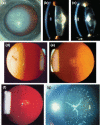Genetics of human cataract
- PMID: 23647473
- PMCID: PMC3991604
- DOI: 10.1111/cge.12182
Genetics of human cataract
Abstract
The pathogenesis of inherited cataracts of all kinds recapitulates the developmental and cell biology of the lens. Just as each novel mutation provides additional information about the structural or functional biology of the affected gene, each newly identified gene provides insight into the developmental and cellular biology of the lens. The set of genes currently known to be associated with cataract is far from complete, especially for age-related cataract, and there is much additional information to be discovered through further genetic studies.
Keywords: cataract; genetics; lens; mutations.
© 2013 John Wiley & Sons A/S. Published by John Wiley & Sons Ltd.
Figures
References
-
- Hejtmancik JF, Kaiser-Kupfer MI, Piatigorsky J. Molecular biology and inherited disorders of the eye lens. In: Scriver CR, Beaudet AL, Valle D, Sly WS, Childs B, Kinzler KW, Vogelstein B, editors. The metabolic and molecular basis of inherited disease. Vol. 8. McGraw Hill; New York: 2001. pp. 6033–6062.
Publication types
MeSH terms
Grants and funding
LinkOut - more resources
Full Text Sources
Other Literature Sources
Medical


